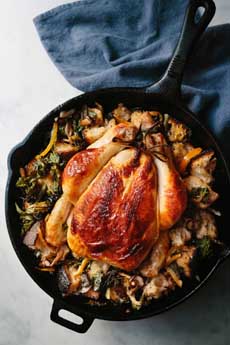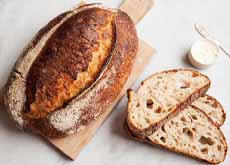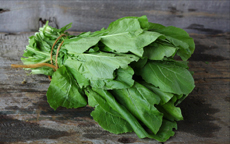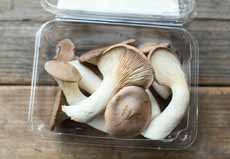RECIPE: Buttermilk Roast Chicken
|
We have roasted chicken on our mind. It’s close to Rosh Hashanah (September 23rd this year), and we’re thinking back to Nana’s roasted chicken. Post-Nana, our roast chicken was never as good, even if we followed the same steps. Nana must have had an understanding with chickens. Until we tried the recipe below, soaking the chicken in buttermilk. Some chefs prefer to soak the chicken overnight. It creates a tender chicken with an extra punch of flavor. Marinating chicken in buttermilk is a time-honored pathway to moister meat, whether roasted or fried. With a bit of advance planning the night before to marinate the chicken, you’re virtually guaranteed a beautifully browned and richly-flavored bird the next day. The recipe is from chef/writer Samin Nosrat. Samin serves the chicken with a panzanella (bread salad with vegetables). In this case, panzanella comprises the greens and rustic bread cooked in the pan. If you’re off bread, simply roast, saute or steam triple the amount of veggies. Samin uses mustard greens. We highly recommend them—they’re a very under-used green. If you don’t like even a hint of mustard flavor, you can substitute collards or kale. Thanks to Good Eggs for sending us the recipe. Don’t need a while bird? Another of our favorite food writers and photographers, the White On Rice Couple, presents this delicious recipe for Milk Roasted Chicken Thighs, using whole milk. With the chicken marinated in buttermilk, you need just 15 minutes of prep time, and 60 minutes to roast the chicken. Ingredients For 4 Servings ________________ |
 [1] With this buttermilk chicken, technique delivers a remarkable bird.
|
|
|
*King trumpet mushrooms, also called king oyster mushrooms and French horn mushroom and eryngii/eringii mushroom and other names, is the largest variety in the oyster mushroom family. It is now being cultivated in the U.S. You can substitute matsutake mushrooms (which may be even harder to find), or any meaty mushroom (perhaps portabella or baby bellas). †Here’s a recipe for preserved lemons; but you only need a bit in this recipe. Check your food store’s olive bar or a Middle Eastern market: You may be able to buy one already made. ________________ Preparation This recipe requires some preparation a day in advance. Beginning the day before you plan to cook the chicken: 1. SEASON it generously with the salt (more salt than you’d use for ordinary seasoning). Let the salted chicken sit for 30 minutes. 2. ADD 3 tablespoons of salt into the container container of buttermilk. Seal it and shake to encourage the salt to dissolve. Place the chicken in a re-sealable plastic bag and pour in the buttermilk. Seal it, squish the buttermilk all around the chicken, place the bag on a rimmed plate or in a pan, and refrigerate. If you’re so inclined, over the next 24 hours you can turn the bag so each part of the chicken gets marinated, but it’s not essential. 3. REMOVE the chicken from the fridge two hours before you plan to start cooking. When you’re ready to roast, preheat the oven to 425°F/218°C. Remove the chicken from the plastic bag and scrape off as much buttermilk as you can without being obsessive (we used a rubber spatula). 4. TRUSS the chicken by placing a 12-inch length of butcher’s twine with its center at the small of the chicken’s back. Tie the twine around each wing tightly and then flip the chicken over and use the remaining twine to tie the legs together as tight as you can. 5. PLACE the bird in a big cast iron skillet or a roasting pan with, the legs pointing toward the rear left corner of the oven. Place in the oven and close the door. You should hear the chicken sizzling pretty quickly. After about 15 minutes, when the chicken starts to brown, reduce the heat to 400°F/205°C and continue roasting. 6. WAIT another 15 minutes, remove the pan and add the shallots/onion, greens, herbs and chanterelles. Using tongs, mix the veggies around in the chicken drippings and place the pan back in the oven, this time with the legs facing the rear right corner of the oven. 7. CONTINUE cooking for another 35-40 minutes, stirring the veggies with tongs once or twice so they cook evenly. The chicken is done when it’s brown all over and the juices run clear when you insert a knife down to the bone between the leg and the thigh. 8. REMOVE the bird to a platter and set it on a cutting board on your counter. Add the bread to the skillet or pan and toss with all of the veggies, making sure to coat the bread evenly in the drippings. 9. RETURN the vegetables to the oven for 10 minutes. When you remove the pan from the oven, add the preserved lemon to the bread and mustard greens. The chicken will be ready to carve and eat immediately.
|
||





